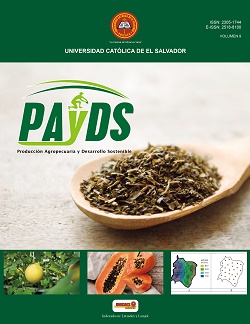Composition and abundance of aphids and the application of mineral oils in progress epidemic of papaya ringspot virus (PRSV-P)
DOI:
https://doi.org/10.5377/payds.v9i0.11841Keywords:
Epidemiology, Potyvirus, Citroline, Saf-T-SideAbstract
The papaya ringspot virus is a limiting factor for papaya production in Michoacán, Mexico. The effect of the weekly spraying of citroline and Saf-T-Side® mineral oils on the visual and serological incidence of the papaya ringspot virus was evaluated in a papaya plantation cv. Red Maradol in Antúnez, Michoacán. There were no significant differences caused by the applications of mineral oils with respect to the control. However, the visual and serological incidence exhibited contrasting results at 32 and 60 days. The epidemics in the control were described using the Weibull model (r2 = 0.97, c = 5.17 and b-1 = 0.013). The area under the disease curve (ABCE) was 6087 percentage days and the final incidence (Yf) was 98%. 309 winged adults of 17 aphid species were collected in Moericke-type traps. The yellow traps captured 60% and the green ones 40%; with significant differences (P <0.05) by species, regarding the trap color. Only Myzus persicae showed a significant difference in the capture of aphids potentially vectors of the papaya ringspot, caused by the trap color. Based on the incidence of papaya ringspot, M. persicae (r = 0.8), Aphis nerii (0.7) and A. spiraecola (0.7) were significantly correlated. However, no correlation was found between meteorological variables and incidence.
Downloads
363
Downloads
Published
How to Cite
Issue
Section
License
© Producción Agropecuaria y Desarrollo Sostenible
Copyright of the articles is transferred to the journal Producción Agropecuaria y Desarrollo Sostenible
As a user of this journal, you have:
- Open access to consult the information contained in this issue
- Permission to copy, distribute, display, perform or combine past practices in the use of information, provided it is strictly non-profit.
This journal uses a CC BY-NC license





